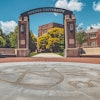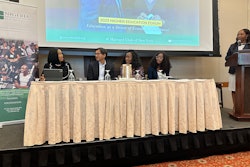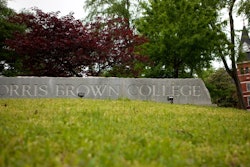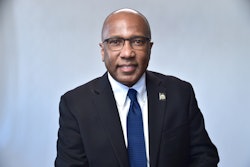Berkeley’s ‘Best-Kept’ Secret
National summit seeks to involve youth in how communities are redeveloped
By Pamela Burdman
BERKELEY, Calif.
“I always planned to drop out of high school and have three kids,” exclaims a  smiling young woman swaddling a baby. “I’ve always wanted to have asthma,” rejoices a corn-rowed teenager, standing in front of a construction site that hints of a new factory in the neighborhood. “I always planned to go to my friends’ funerals on Saturdays,” says a third young woman, a granite monument visible behind her stark silhouette. In each of the scenes, the inviting images contrast sharply with the harsh words as they repeat on a Macintosh screen in a windowless room on the University of California-Berkeley campus.
smiling young woman swaddling a baby. “I’ve always wanted to have asthma,” rejoices a corn-rowed teenager, standing in front of a construction site that hints of a new factory in the neighborhood. “I always planned to go to my friends’ funerals on Saturdays,” says a third young woman, a granite monument visible behind her stark silhouette. In each of the scenes, the inviting images contrast sharply with the harsh words as they repeat on a Macintosh screen in a windowless room on the University of California-Berkeley campus.
At the controls are five young women, the same youth who appear in the footage. Each comes from a different part of the country — Birmingham, Ala., Los Angeles, Charleston, S.C., Phoenix, and nearby Oakland, Calif. What the 14- to 22-year-olds share is a connection to federal housing projects that are being converted to mixed-income communities in a project known as Hope VI.
Using footage shot around campus and a little ingenuity (a water bottle and cookie box wrapped in a sweater became the baby, a campus engraving was enlisted as a headstone, and a campus construction site doubled as a factory going up), the students are crafting public service announcements about healthy communities. The plan is to take the 30-second spots back to their regions, but more important are the skills the youth have come to learn with assistance from Berkeley graduate students and leaders from an Oakland nonprofit called Youth Sounds.
In nearby classrooms, other students are learning graphic arts and radio broadcasting with coaches from Below Radar graphics and Youth Radio. And in a separate workshop, a group of adult chaperones is meeting with housing officials, planning researchers and community leaders to learn the ropes of the housing system and discuss ways of getting young people more engaged.
Bringing together youth and adults from 15 Hope VI projects around the country, the Youth Leadership for Change is the third national summit of its kind. HUD used to fund the program, but now support comes from the Annie E. Casey Foundation, the Robert Wood Johnson Foundation and the San Francisco Foundation. At least some participants say the experience has been invaluable.
Monique McKinstry of Birmingham, Ala., says her attendance at the last two summits led to her current role as a youth coordinator for the federal Housing Authority in Birmingham, and she expects this summit to do the same for other young people. “They get to see kids from other areas doing things, then they jump into action,” Monique says.
Now an international studies and marketing major at the University of Alabama at Birmingham, Monique helped start a youth board for Metropolitan Gardens, the community where she lived with her mother until the residences were demolished. “If youth (are) not there, it’s not going to be good,” says McKinstry, underscoring the raison d’etre for the national summits — to involve youth in the conversation about how communities are redeveloped.
“In most of the developments, children and youth are over 20 percent of the communities,” says Dr. Deborah McKoy, director of UC Berkeley’s new Center for Cities and Schools, which will formally open in September. “We set out to find ways to engage them realistically, to share some of these tools as to how you actually talk to developers and public housing officials about what you think is important. With youth in the inner city, space is often the only thing they have… their turf. If you take that away, they don’t have a lot left.”
Professor David Dowell, director of the Institute for Urban and Regional Development, which will house the new center, says the program dovetails with research being conducted on campus. “It’s a national outgrowth of our longstanding research about how to improve the quality of these housing developments,” he says. “Our commitment is to look at how to link education and community development.”
By design, the program takes place on campus, with the youth living in dorms, in order to expose them to the college environment, many for the first time.
To Earnest McDuffie, nothing could be more important. McDuffie grew up in the Red Oak housing project in Atlanta’s Fulton County. At the time, he was the only teen from his community in a three-year period to finish high school. With help from a Hope scholarship, McDuffie recently completed an electrical engineering degree through a joint program of Georgia Southern University and Georgia Tech.
He turned down engineering jobs to return home to work for the housing authority, engaging former residents in rebuilding the community. “My focus is on creating opportunities for the youth,” says McDuffie. “It’s a paradigm shift from self-sufficiency to independence, from rental to home ownership, from unemployed to employer. This program seems to be one of Berkeley’s best-kept secrets.”
© Copyright 2005 by DiverseEducation.com





















